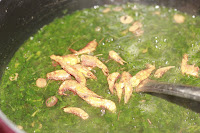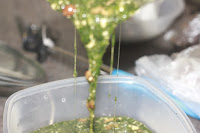Ewedu is a popular soup mostly eaten by the yoruba tribe in Nigerian, if you have any friends or family that comes from Oyo or Ibadan (my grandma was from Ibadan), or any ties with these 2 cities you would have most likely tasted this soup before. This was certainly my grandma's favourite soup and it just had to be at home. And of course it usually goes down with Amala (oh my days).
I have never and I mean never or let me say I'm yet to taste any ewedu taste as good as my grandma's ewedu. I wish it was possible for her to have cooked a lifetime worth of ewedu for me before passing on (God rest her soul). If you could cook ewedu to my grandma's satisfaction mehn! you are a star, I gave up trying. Oh, how I wish I could taste Mama's (as we fondly called her, or spell it out M-A-M-A when we wanted to gossip about her in her pressence) ewedu one more time. I have since accepted that I will never be able to taste ewedu cooked by Mama again but also I've also determined to keep trying to get my ewedu games up to Mama's level. Ok so lets give it another try, shall we?
Ingredients
Ewedu leaves (corchorus olitorius/Jute)
Potash (A small sized stone or 1/2 tsp if powdered)
1 cup of water
Ijabe (Ewedu Broom) or a blender
Salt to taste
1 cube of seasoning
Egusi
2-3 teaspoons of ground crayfish
Potash (A small sized stone or 1/2 tsp if powdered)
1 cup of water
Ijabe (Ewedu Broom) or a blender
Salt to taste
1 cube of seasoning
Egusi
2-3 teaspoons of ground crayfish
A few pieces of whole Crayfish
2 tablespoon of Egusi (ground melon seeds)
2 tablespoon of Egusi (ground melon seeds)
Preparation
You can either buy fresh ewedu leaves this means that you have to pick the leaves from the stem, as you only need the leaves. Or you can buy the frozen leaves from the Asian/ African grocery shop, this would have have been picked. I have used the fresh one and I've picked and washed the leaves.
Place the water in a pot, add a small stone or 1/2 tsp of potash and bring water to boil.
Pour in the washed weed leaves and leave to continue boiling in the water.
Check to see if the leaves have soften once the are soft enough, pour this in the blender (or you can use what we call Ijabe (this is like a small short broom) to manually chop the leaves).
Otherwise, pour in a blender and use the pulse button "P" a couple of times to chop the leaves, you don't want this all smooth.
Pour the soup back in the pot and place back on heat, add the iru (locust beans)
Add some cray fish, it better to use the ground crayfish.
Add 2 tablespoon of grounded egusi (grounded melon seeds, this is optional) you can have it plain if you prefer.
Add salt and seasoning cube to taste.
Please note that you need to be fast as possible so the the soup still maintains its greens and still drawy. The beauty of ewedu is in its drawiness i.e its sliminess (if there's any word as such)


Ewedu is usually paired with its twin sister "Gbegiri" and eaten along with Amala
It was once said that if yoruba people were to have their own flag it will be in the colours of these 2 soup, "Ewedu & Gbegiri"





















































